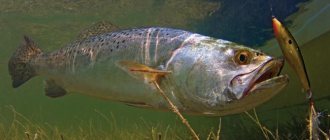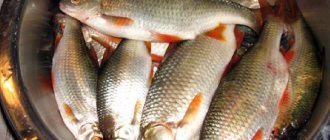Preparing caviar
Salting red caviar begins with its preparation. Ideally, you need to remove caviar from fish within 30-45 minutes after it is caught. If this is done with a delay, the film to which the caviar is attached will lose strength and may burst earlier than necessary.
Pink salmon with caviar
According to GOST, red caviar must be salted no later than 6 hours after it is caught.
Unfortunately, this is only possible if you caught the fish yourself or on fishing vessels. In other cases, you will have to work with what you have.
On the mainland, you can “get” fresh caviar by buying a whole fish carcass. It is best if it is a female pink salmon or chum salmon. Females and males of salmon differ in color. Choose lighter colored fish with a round head shape.
It is recommended to take fresh fish, but under the guise of fresh, they often sell defrosted fish. Therefore, it is difficult to recommend anything here.
If you have frozen fish, you need to defrost it correctly: place it in the refrigerator for 4-6 hours, and only then defrost it at room temperature.
Rapid defrosting is not allowed, as the caviar will begin to leak and become unsuitable for salting.
After the fish is completely defrosted, it must be very carefully ripped open and removed without damaging the film in which the caviar is located.
If the oyster is still damaged, all further actions with the eggs are carried out only in salt water. Contact of caviar with fresh water is not allowed.
Salting caviar is somewhat more difficult than salting fish, but easier than making balyk from fish.
How to salt red caviar: “wet” recipe
Ingredients:
- Red caviar – 150 g.
- Water - 1 l.
- Salt - 5 tbsp.
- Sugar - 1 tbsp.
Preparation:
- First you need to prepare a strong saline solution.
- Pour 1 liter of water into a saucepan.
- Add salt and sugar, put on fire. The water needs to be boiling.
- When all the salt has dissolved, cool the solution to 50 degrees.
- The caviar is contained in a film called yastek. To release the calf, you can use the methods described here. Alternatively, place the bags in the saline solution and start stirring with a fork. Simple movements, like beating eggs.
With this method, we kill two birds with one stone - we remove the film and begin the salting process. The optimal time for caviar to remain in the salt solution is 15 minutes.
- After cleaning the caviar and waiting time, pour the brine through a colander or strainer.
Caviar salted in this quick way can stay in the refrigerator in a glass container for no more than 2 - 3 days.
Stage four: storage
Store home-salted caviar in the refrigerator, covered. The timing depends on which of the two salting methods was used. The dry method allows you to store caviar in a sterile jar for 2-3 weeks, and using brine for no more than 2 days. Ready-made lightly salted red caviar can also be frozen. A frozen product can be stored without losing its quality for up to six months.
In any case, homemade lightly salted red caviar is a feast for gourmets! Try using our tips to prepare this delicacy yourself.
You shouldn’t stop at just salting the caviar; lightly salted fillets of salmon species such as salmon, chum salmon or budget pink salmon are very tasty.
We are confident that you will cope with this task. As an assistant, you can use materials from our website with interesting recipe collections. Tweet
Salting red caviar: a classic recipe
This is a dry technology that does not involve the participation of water. Red caviar - dry salting at home.
Ingredients needed:
- red caviar - 500 g;
- salt - 3 level tablespoons.
Recipe (steps step by step)
Step 1. Gut the fish, remove and wash the fish, remove the film.
Step 2. Place a layer of salt (quite dense) on the bottom of the pan, add an even layer of eggs, and sprinkle a little on top as well. Several more layers are created in exactly the same way.
Step 3. Place the product in the refrigerator, and after 3-4 hours lightly salted red caviar is ready. A medium-salinity product will be ready in 10-12 hours (just put the caviar in the refrigerator overnight).
How to salt pike perch caviar
- Caviar – 800 g
- Salt – 300 g (volume for solution)
- Water – 3 l
- Salt - 1 teaspoon
- Vegetable oil – 4 tablespoons
Preparation:
A large portion of salt, of course, is used to prepare the brine. Before salting pike perch caviar at home, it is poured several times to remove films. If everything worked out, the caviar was strained and dried, it’s time to start salting.
Take a glass jar, pour a little oil into it, put salted caviar, and again pour an oily layer on top. Cover tightly and refrigerate. After a few hours, the caviar can be spread on sandwiches. With the right actions, the caviar treat turns out to be non-crumbling, tender, and appetizingly golden in appearance.
How to salt red caviar: dry salting
This method of salting will allow you to store caviar in the refrigerator for up to 2 weeks.
Ingredients:
- Red caviar - 1 kg.
- Coarse salt - 2 tbsp.
- Vegetable oil - 2 tbsp. spoons
Preparation:
- The process begins with releasing the eggs from the cage (if this has not been done in advance). To do this, place the caviar in a colander. Place it in boiling salt water and soak for 25 - 30 seconds.
- Then pass the caviar through a large mesh sieve.
- Then place in an enamel bowl and gradually add salt, while stirring with your hands or a wooden spatula.
- When finished, distribute the caviar into pre-sterilized glass jars.
- Add vegetable oil on top and close the lid.
How to salt perch caviar
River fish is a separate category. Perch is a predator, and eating it raw is a health risk. This also applies to caviar. You can, of course, if you really want, use any of the above recipes for pickling raw offal. We recommend salting river fish caviar differently. This is how you can salt perch caviar.
- Perch caviar
- Liter of water
- Salt – 2 tbsp.
- Coriander – 1 tsp.
- Bay leaf – 2 pcs
- Peppercorns and ground
Use a spoon to remove the eggs from the bags. They are small and not so damaged.
Prepare the brine with the addition of salt and spices. The marinade is obtained a few minutes after the start of boiling. Pour our caviar directly hot. It is infused and salted for 20 minutes.
Strain and remove excess water. We place the dishes containing the semi-finished product in a steam or water bath. We bring it to readiness in this way. Stir for 20 minutes.
You can diversify the taste with lemon juice; vegetable oil will help preserve the snack longer. To prevent it from spoiling, it must be kept in a glass container, without access to air.
How to salt red fish caviar according to GOST
Red caviar, salted according to GOST, has the highest quality and the most pleasant taste. At home, it is quite difficult to pickle a product in this way if you follow all the rules. Still, it's worth a try.
- Ideally, in accordance with GOST, red fish caviar should be salted for 6 hours. after the fish has been caught.
- The second requirement is for brine - a solution for salting a valuable product. It should be prepared exclusively from boiled water cooled to 10°C and salt.
- The third requirement concerns the packaging of ready-made caviar, but in principle it does not concern us, since caviar prepared at home is rarely stored for more than a few weeks.
Caviar
So, prepare the following products:
- Red fish caviar – 1 kg
- Water – 2 l
- Salt
- Refined vegetable oil – for storage
- Fresh egg to determine water salinity
Recipe:
- We take the caviar from the previously defrosted fish. If you bought frozen caviar separately, defrost it this way - within 5 hours. in the refrigerator, and then until completely defrosted at room temperature
- Rinse the eggs in cold water.
- Clean the caviar from films using one of the methods described above. If you are salting a product for the first time, give preference to the option with a mixer.
- Boil the specified amount of water, and then start adding salt to it. You will need quite a lot of salt. In order not to miscalculate its quantity, place a fresh egg in a container of water. When the liquid is salty enough, the egg will float.
- Leave this solution to cool. If you want to follow all the rules, let the solution cool to 10°C.
- Pour the resulting solution over the caviar, cleared of ostriches, and leave it for 10-20 minutes.
According to GOST
- To check if the product is ready, take a few eggs and crush them with your fingers. If the liquid splashes, it means that the caviar has not yet been salted enough, but if it flows like an oil solution, it means that the product has been salted.
- Place the salted caviar on cheesecloth, hang the gauze over a basin and let the liquid drain. This process will take no more than a few hours.
- Prepare containers for storing the delicacy - sterilize glass containers, rinse plastic containers in a solution of water and salt.
- Place the product in containers, season it with a little oil and store it in a cool place.
- This product is not recommended to be stored for too long. It is best to eat caviar within a few weeks.
How to pickle red caviar at home, tasty and quick
A homemade delicacy can be no worse than store-bought. Therefore, it is important to buy a fresh product and follow the cooking technology. It is better to choose fish from the salmon order with red meat.
Since most stores sell fish frozen, the question arises: is it possible to salt caviar from frozen pink salmon? It is possible, but the carcass must be carefully defrosted first.
Ingredients:
- pink salmon caviar – 400 – 500 grams;
- purified water – 1 liter;
- white sugar – 1.5 dessert spoons;
- rock salt - exactly 5 teaspoons;
- seasoning for fish - optional.
Steps:
- The first step is to defrost the fish carcass naturally. First place the fish in the refrigerator, then defrost it in the kitchen at normal temperature. Carefully cut the belly with a knife, starting from the lower rear fin. Get the main ingredient.
- Now it is important to separate the eggs from the films. You can do this with your hands by tearing the bag. Place them in warm, clean water to quickly separate the excess from the eggs. Slowly stir in a circle with a wooden skewer. The film comes off well. Strain the contents through a sieve and dry on a cloth towel.
- How to pickle red caviar from pink salmon at home? Next, cook the brine, it is also called brine. Boil the specified amount of liquid, stir in a portion of table salt and sugar. The salty brine prevents the eggs from sticking to each other. Cool the liquid and pour the resulting brine into the container with the caviar for half an hour.
- The last step is to strain the eggs through a fine sieve or cheesecloth. Then place them in a dry glass jar. Now, wondering whether it is possible to salt caviar from frozen pink salmon, it is not difficult to repeat this recipe. However, the shelf life of the delicacy on the refrigerator shelf should not exceed 4 days.
“Lightly salted” with vegetable oil
For the same 500 grams you will need:
- 15 grams of salt and sugar;
- 25 grams of refined, odorless oil (this is important!).
How to properly salt with butter? In a glass jar, mix the oil and bulk ingredients, stir to dissolve.
Then add the washed caviar and mix very carefully so that the eggs are not damaged. You can close the lid and gently swirl the jar to distribute the ingredients evenly. If you like a saltier snack, add more salt.
How long will it take? Place the jar in the refrigerator for 8–10 hours, after which the product will be ready for use. You can store it longer - on average for 10-14 days.
Five-minute caviar. Recipe
Five-minute caviar is made from fresh fish roe and is rightfully considered one of the most delicious dishes. In addition, it retains all natural properties, which is why it is very useful.
To prepare the “five-minute” you will need:
- Red caviar
- 1 liter of water
- 6 tablespoons of salt (heaped).
Perhaps it’s worth starting with the fact that you need to get the most important ingredient - caviar. To do this, you need to rip open the belly of the “female” and remove the eggs into a bowl. Then, using a net, you need to break through the eggs. The net should be such that the eggs can easily pass through it and be cleared of excess mucus.
You can also clean the caviar using a knife. Having placed it on a cutting board with the eggs down, you need to push them out of the chaff with the back of the blade. It is better to start this action from the edge so as not to crush the eggs.
The next step is preparing the brine. Fishermen know the meaning of this word very well. For those who have not “hunted” fish, let us explain that this is just a solution for salting fish and caviar. To make this solution, you need to boil water, pouring salt into it so that it completely dissolves. It is better to remove the remaining undissolved salt. The brine needs to be cooled to room temperature.
Place caviar in the resulting solution and leave it for 5 minutes. Next, use gauze to strain the resulting dish. To get as much water out as possible, it is better to carefully roll the caviar on gauze.
The resulting caviar can be safely served. Some people like to spread it on black bread, some prefer to wrap it in a pancake, and others can simply eat it with tablespoons.
You can store this caviar in the refrigerator for no more than 3 days. However, as fishermen say, “five-minute” is not because it cooks quickly, but because it is eaten in 5 minutes.
Stage Three: Ambassador
In brine
Brine is a concentrated salt solution that is prepared both for salting caviar and fish meat. The technology for its preparation is simple: dissolve 2 tablespoons of coarse table salt and 1 large spoon of sugar in a glass of cool water. You can check the quality of the brine using a raw egg or a small peeled potato. With sufficient salt concentration, these products will float.
The caviar is placed in the curing solution for 7-9 minutes. In this case, the caviar will turn out lightly salted. If you keep the eggs in brine for 15 minutes, the degree of salting will be maximum.
The caviar is dried on a gauze cloth and then transferred to a small container, adding ½ teaspoon of vegetable oil.
Elena Puzanova in her video offers her recipe for salting pink salmon caviar
Dry salting
Washed eggs (100-150 grams) are sprinkled with a teaspoon of salt (with a small slide) and sugar, taken in half the amount. The caviar is gently mixed and left for 5 minutes. The stirring and five-minute infusion procedure is repeated 3 times. The finished lightly salted red caviar is transferred to a metal grid and the resulting liquid and the remainder of the curing mixture are allowed to drain.
The delicacy is transferred to a jar, the walls of which are greased with vegetable or olive oil. To make the caviar crumbly, oil (no more than ½ teaspoon) is added to the caviar itself.
The option of salting with food-grade potassium nitrate to preserve the rich color of the eggs is described in detail in our article.
Red caviar - five minutes
Ingredients
- Red caviar
- Salt
When cutting fresh red fish (trout, salmon, chum salmon, sockeye salmon, pink salmon and others), red caviar is sometimes found; it can be prepared at home or on the go in just a few minutes using the following recipe.
01. Trout with caviar
First of all, two eggs with caviar must be removed from the fish. Red fish contains a lot of caviar - up to 30% of the weight of the fish. In the example, fresh trout weighing about 2 kilograms contained 250 grams of caviar.
02. Two eggs with caviar
When the eggs are removed, the eggs should be torn apart, removing the films as much as possible, but you should not try too hard - there is a risk of bursting the eggs. It will be much easier to remove the films later. In the meantime, the main thing is to loosen the caviar a little so that it does not lie in too big a lump, otherwise it will be salted unevenly.
03. We tear apart the yasytki
The eggs must be thoroughly washed in cool running water to remove any remaining blood, mucus and the contents of burst eggs. A fine-hole colander or sieve is suitable for rinsing.
04. Wash the caviar
The washed caviar should be generously salted at the rate of one heaped tablespoon of salt for every 100 grams of caviar. It will not work to over-salt as the caviar will not take up the excess salt. After pouring out the salt, mix it with the caviar and leave to infuse for 5 minutes. Due to the fact that the caviar is salted for 5 minutes, the recipe is called “five-minute”.
05. Salting caviar
After 5 minutes of salting, the caviar should be poured with boiling water. It is worth paying attention that it is better to put the kettle on in advance, as it can boil for more than 5 minutes.
06. Pour boiling water
Then the water must be drained through the same colander or sieve. After heat treatment, the films from the caviar are much easier to remove, but it is still quite painstaking and tedious work that takes up most of the time for preparing red caviar.
07. Drain the salt water
Ready red caviar should be stored in the refrigerator. It is best to make classic sandwiches from caviar on fresh white bread with butter.
How to pickle river fish caviar - for sandwiches
This is how unpresentable caviar looks after gutting the fish.
- We clean from film and blood.
Transfer the caviar into a saucepan.
- Take a sharp, thin, narrow and long knife.
- And, with quick cutting movements, we cut through all the joints. (Yastyk is a caviar sac taken from a fish)
- It turns out to be such a uniform mass.
- Now take another saucepan. It is more convenient when it has a slightly larger volume.
- Pour coarse rock salt into it, two heaped tablespoons.
- Take one liter of water.
- Mix and dissolve the salt in water, i.e. we get brine. (Brine is a saturated solution of table salt)
- Place the saucepan on the fire.
- Bring the brine to a boil.
- Remove the brine from the heat and immediately pour it into the caviar.
- (This amount of brine and salt is used if you have up to a liter jar of caviar. If there is more caviar, multiply everything by 2.)
Never pour out all the brine, as there is a lot of sand in the salt.
- It turns out to be caviar drenched in hot brine. This is what it looks like.
- We take a fork. And mix the caviar with quick circular movements for a couple of minutes.
- Now you need a fine strainer.
- Using a strainer, scoop the caviar out of the saucepan and transfer it to another container.
- As you can see, the brine remains cloudy and dirty after this.
- At this stage, you can leave some liquid in the caviar for now, i.e. do not wait until all the brine has drained through the strainer.
- Let's make brine again. (2 heaped tablespoons of salt, a liter of water, put it all on the fire and bring to a boil)
- Pour in the caviar again, mix and remove the films. They wrap easily around the fork. Those that do not wind up need to be removed one at a time.
- This is how many curled films are obtained from that amount of caviar.
- After the second filling with brine and removing the films, we get fairly clean caviar, all the eggs are separated.
- We make brine for the third time.
- Now the caviar looks very good, the brine remains clean and transparent after pouring and mixing.
- Now we again scoop up the caviar with a strainer and, each time, wait 1-2 minutes until the brine completely drains through the strainer.
- When all the brine has drained, place the caviar on a clean plate.
- When all the caviar is laid out, take a suitable sized jar and a small amount of sunflower.
Pour some oil into the bottom of the jar.
- Take caviar with a tablespoon.
- And put it in a jar.
- Now take fine salt.
- A small coffee spoon.
- And pour a little fine salt into the caviar.
ATTENTION! The amount of salt that is in the spoon in this photo is suitable for those who like very salty caviar (it tastes like over-salted caviar), if you like not very salty caviar, add one quarter of the volume of this spoon.
- Mix fine salt with caviar.
- When all the caviar is placed in the jar, tamp it down with a spoon.
- Pour a little more oil on top.
- Now take the glass lid. If you don’t have such a lid, take a small saucer or a regular plastic lid. Cover the jar.
- And put the caviar in the refrigerator for several hours. I usually keep caviar in the refrigerator for 4-5 hours. During this time, the eggs swell, absorb salt and oil, and increase in volume.
After 5 hours you can do whatever you want - eat it with a spoon, spread it on sandwiches, treat your friends...
Tips for preparing red caviar:
- It is most convenient to remove caviar if the fish is not completely defrosted.
- If you don’t have a drain, then the caviar in the solution can be transferred to cheesecloth and, carefully rolling the delicacy, ensure that the liquid drains completely. You will need help in this matter, since holding the gauze on both sides at the same time and rolling the caviar alone is problematic.
- It is recommended to keep the caviar in the solution for 10 minutes. The time depends on your preferences. The saltier you like your caviar, the longer you keep it in the solution. And remember that lightly salted caviar cannot be stored for long periods of time.
- In the refrigerator, you need to store caviar in tight glass jars with a lid. The delicacy is also suitable for freezing. If you do not defrost it, the shelf life reaches 6-8 months.
Now you know how to pickle caviar at home. To prepare the delicacy, you can use fresh caviar if you live in the fishing area, or buy frozen, ungutted fish. The second option is more complicated, but allows you to save money and, in addition, get delicious salmon, which makes excellent main courses and snacks. Fish meat can also be salted in brine, resulting in several pieces of the delicacy.
Stage two: caviar cleaning
The “bags” in which the caviar is located are called yastyk. This is a kind of chaff that must be removed before salting. There are several ways to clean caviar:
- Using a grid. The main condition: the cells must be 3 times larger than the eggs. It is very convenient to use a tennis racket or badminton racket at home. The caviar is transferred to a “grid” and “grinded” through large cells with gentle movements. All that remains is to rinse the caviar in water.
- Manually. The caviar is separated by hand, lightly rolling the eggs over the palms. The yastik rolls up and is removed.
- Using a skewer. The caviar bags are torn by hand, and their contents are poured with cool water. Using a roll stick, stir the caviar in one direction. During this process, the remaining film is wrapped around the stick and can be easily removed.
After cleaning, the eggs are rinsed in water and placed on a sieve with gauze. When the water has drained, the caviar is rolled over a gauze cloth several more times to finally get rid of any remaining film and damaged grains.
Watch the video of farmer Sabaneev about parsing yastyk with red caviar











